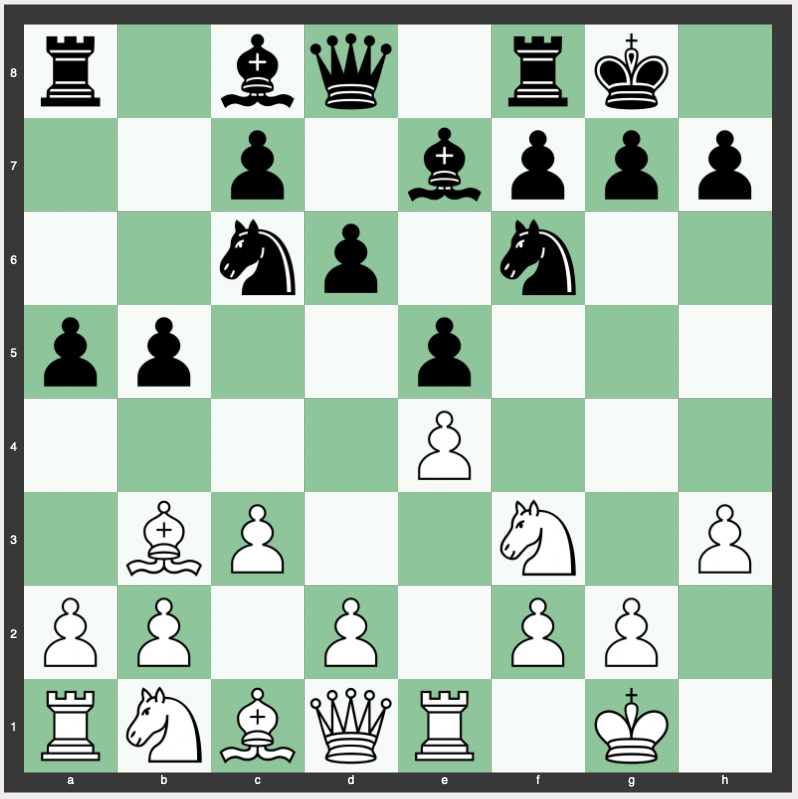The Keres Variation of the Ruy Lopez is a rich and complex opening that has been played at the highest levels of chess.
Named after the Estonian Grandmaster Paul Keres, this variation has been a battleground for many theoretical debates and has been employed by numerous World Champions.
Below we look at the move order, the underlying theory, strategy, and purpose, the variations, its history, its suitability for beginners and intermediates, and its frequency of play at the Grandmaster level.
Move Order of the Keres Variation
The Keres Variation follows the sequence: 1. e4 e5 2. Nf3 Nc6 3. Bb5 a6 4. Ba4 Nf6 5. O-O Be7 6. Re1 b5 7. Bb3 d6 8. c3 O-O 9. h3 a5.

This move order is a specific path within the Ruy Lopez, one of the oldest and most respected chess openings.
Theory, Strategy, and Purpose of the Keres Variation
The Keres Variation is a deep and strategic opening.
It aims to create a flexible pawn structure for White, while also allowing for active piece play.
Black’s pawn moves on the queenside are designed to gain space and challenge White’s central control.
Both sides must play with precision, as small inaccuracies can lead to significant disadvantages.
Sub-Variations of the Keres Variation
Within the Keres Variation, there are several sub-variations that can arise.
These include different responses to White’s 9th move, as well as various move orders leading to similar positions.
Understanding these sub-variations is essential for players who wish to specialize in the Keres Variation.
The best response is considered 10.a4 or 10.d4.
10.a4 or 10.d4?
10.a4 helps to slow down white’s queen-side initiative and prevent black from playing a4 on move 11 or 12 (as it goes in many lines) while 10.d4 is a traditional move around this time in Closed Ruy Lopez openings to take control of the center.
10.a4 tends to produce less variety in the lines due to a series of exchanges that typically follows, as shown in our continuation lines below.
10.d4 offers more variety and is considered slightly stronger overall.
Evaluation of the Keres Variation
The evaluation of the Keres Variation is +0.70, providing white a quality advantage.
Continuation Lines of the Keres Variation
Sample continuation lines of the Keres Variation that would be seen at the highest levels of play include:
10.d4
10. d4 Bd7 11. Nbd2 Re8 12. Nf1 a4 13. Bc2 h6 14. Ng3 Bf8 15. Be3 a3 16. b3 b4 17. c4 exd4 18. Nxd4 Nxd4 19. Qxd4
10. d4 Bd7 11. Qe2 Re8 12. Na3 b4 13. Nc4 a4 14. Bc2 exd4 15. cxd4 d5 16. Ncd2 dxe4 17. Nxe4 b3 18. axb3 axb3 19. Rxa8 Qxa8 20. Bb1 Nxe4 21. Qxe4 g6 22. Qd5 Bd6 23. Rxe8+ Bxe8 24. Qxb3
10. d4 Bd7 11. Qe2 a4 12. Bc2 Re8 13. Na3 exd4 14. Nxb5 dxc3 15. Nxc3 Ne5 16. Qd1 Nxf3+ 17. Qxf3 Bc6 18. Qd1 d5 19. exd5 Nxd5 20. Bxa4 Bxa4 21. Qxd5 Bb4 22. Rxe8+ Qxe8 23. Nxa4
10. d4 Bd7 11. Qe2 a4 12. Bc2 Rb8 13. d5 Na5 14. Na3 Qc8 15. b4 axb3 16. axb3 c6 17. b4 Nb7 18. dxc6 Qxc6 19. Bd3 Nd8 20. c4 bxc4 21. Nxc4 Qb7 22. Bd2 Bb5 23. Na5 Bxd3 24. Qxd3 Qb5 25. Qxb5 Rxb5
10.a4
10. a4 b4 11. d4 bxc3 12. bxc3 exd4 13. Nxd4 Nxd4 14. cxd4 d5 15. exd5 Bb7 16. Nc3 Bb4 17. Bd2 Nxd5 18. Ne4 Re8 19. Bxb4 Nxb4 20. Qg4 Bd5 21. Bxd5 Nxd5
10. a4 b4 11. d4 bxc3 12. bxc3 exd4 13. Nxd4 Nxd4 14. cxd4 d5 15. exd5 Bb7 16. Nc3 Bb4 17. Bd2 Nxd5 18. Ne4 Re8 19. Qc2 Bxd2 20. Qxd2 Nb4 21. Nc3 Qd7 22. d5 h6 23. Rxe8+ Rxe8 24. Rd1 Ba6 25. Qd4
10. a4 b4 11. d4 bxc3 12. bxc3 exd4 13. Nxd4 Nxd4 14. cxd4 d5 15. exd5 Bb7 16. Nc3 Bb4 17. Bd2 Nxd5 18. Ne4 Re8 19. Qc2 Bxd2 20. Qxd2 Nb4 21. Nc3 Qf6 22. Rad1 h6 23. d5 Rad8 24. Re3 Rxe3 25. Qxe3 Qg6 26. Qc5 Qb6
10. a4 b4 11. d4 bxc3 12. bxc3 exd4 13. Nxd4 Nxd4 14. cxd4 d5 15. exd5 Bb7 16. Nc3 Bb4 17. Bd2 Nxd5 18. Ne4 Re8 19. Qc2 Bxd2 20. Qxd2 Nb4 21. Nc3 Qf6 22. Rad1 h6 23. d5 Rad8 24. Rxe8+ Rxe8 25. Nb5 Re7 26. d6 Qg6 27. f4 cxd6
History of the Keres Variation
The Keres Variation is named after Paul Keres, an Estonian Grandmaster and one of the strongest players never to have won the World Championship.
It has been played by many World Champions and elite players throughout history.
The variation has undergone significant theoretical development, with new ideas and refinements continually emerging.
Is the Keres Variation Good for Beginners or Intermediates?
The Keres Variation can be a challenging opening to learn, particularly for beginners.
Its complexity and depth may be more suitable for intermediate and advanced players who have a solid understanding of chess principles.
However, studying this variation can provide valuable insights into strategic concepts and positional play.
How Often Is the Keres Variation Played at the Grandmaster Level?
The Keres Variation is a respected and frequently played opening at the Grandmaster level.
It has been featured in many high-profile games, including World Championship matches.
Its enduring popularity attests to its soundness and richness as a chess opening.
Ruy Lopez: Keres variation
Conclusion
The Keres Variation of the Ruy Lopez is a fascinating and complex opening that offers rich strategic play.
While it may be more suitable for intermediate and advanced players, its study can provide valuable insights for players of all levels.
Its history, variations, and frequent use at the Grandmaster level make it an essential part of the chess landscape.
Whether you are a seasoned competitor or an aspiring chess enthusiast, the Keres Variation offers a deep well of ideas and challenges to explore.


